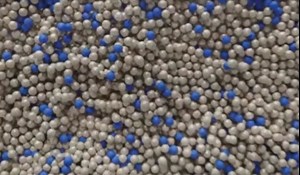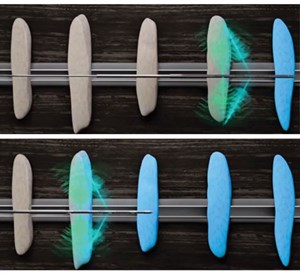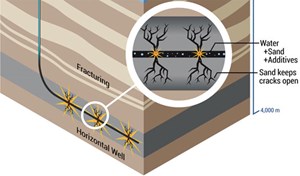What's new in production
In my June 2021 column, I introduced a product called SCANITE,™ developed by Oceanit Laboratories. I also mentioned that this company is extremely clever when it comes to developing industry-focused technologies that can be implemented in the field quickly.
This month, I’m going to present to you a cousin to SCANITE.™ VuFrac™ was developed for the upstream oil & gas industry to allow operators to answer the post-frac question: “Where did my proppant go?” This information is critical to understanding well performance, estimating wellbore reserves, and planning future frac jobs in the area.
VuFrac is a meta-material that is mixed in with the frac proppant (shown as the blue spheres in Fig. 1). These spheres are engineered to be acoustically “transparent” at particular frequencies, allowing background formation mapping, while making the proppant “opaque” at adjacent frequencies, permitting localization of its placement. Furthermore, the metamaterial proppant is responsive to mechanical stress, and in other versions, chemical conditions—allowing evaluation of subsurface conditions.
This allows the operator to better understand the following post-frac parameters: a 3D mapping of proppant distribution geometry in the producing formation (up to 1,000 ft away from the wellbore); proppant bed height; convergence and flow directions; perforation efficiency; frac stage isolation effectiveness; and details about wellbore connectivity.
The material is compatible with conventional sonic downhole and seismic profiling techniques. Operators can run an acoustic log immediately after well unloading to get an initial reading of proppant geometry. Figure 2 depicts a conventional sonic logging tool “seeing” the proppant as transparent or opaque. From this acoustic log, the geometry of the proppant in relation to the wellbore, as shown in Fig. 3, can be determined. Sonic logging tools also can be run throughout the life of the well, perhaps in conjunction with other production logging tools, to evaluate well performance or to identify completion problems within the structure of the proppant.
Consider my October 2020 column, “It’s hard to fool Mother Nature….but not impossible.” Incorporating VuFrac into the proppant design for an omnidirectional frac could provide proof of the effectiveness of the NaturaFrac technology. Oceanit has been “calibrating” this technology in lab tests in Hawai’i, and in full-scale tests near their facilities in Houston, Texas. I’m very much looking forward to seeing the results of their first field trial, once it is done.
Future development of this technology is ongoing. Oceanit has recently demonstrated using VuFrac at acoustic seismic frequencies. In theory, this could greatly enhance the ability to use active microseismic technology to evaluate fracture geometry—perhaps even in real time. This ability could add tremendous value to the execution of frac jobs by allowing frac pumping operations to be adjusted “on the fly” to accommodate actual results. Learn more about VuFrac at: https://www.oceanit.com/products/vufrac/
And again, thinking small can yield huge values to upstream oil & gas operations.
- Digital transformation/Late-life optimization: Harnessing data-driven strategies for late-life optimization (March 2024)
- The reserves replacement dilemma: Can intelligent digital technologies fill the supply gap? (March 2024)
- Digital tool kit enhances real-time decision-making to improve drilling efficiency and performance (February 2024)
- When electric meets intelligence: Powering a new era in hydraulic fracturing (January 2024)
- Digital transformation: Digital twins help to make the invisible, visible in Indonesia’s energy industry (January 2024)
- Digital transformation: A breakthrough year for digitalization in the offshore sector (January 2024)





